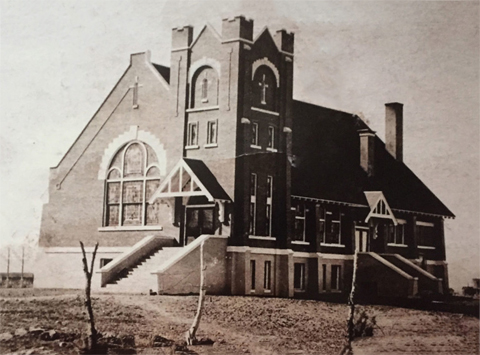By: Cameron Wright, the winner of the 2013 8th grade History Project for “Most Historical” with his research on the “Tithing Granary”.
The Tithing Granary was an important economic feature of Malad, Idaho. It was located near the historic Malad Co-op building during the 1860’s and then later moved to its current location today, behind Ireland Bank. D.L. Evans and Lorenzo Thomas bought it in 1884, when the Malad Co-op went bankrupt. The Evans family owns it today and is on their private property.
The cooperative system was adapted from England, where there was a central station where people could come and get all their goods (soap, material, wool, tools, furniture, etc.) The people didn’t want to have to rely on Eastern goods, so by having this Co-op, it separated itself from the country’s economy. Cash was very scarce among the people who settled here, and families were either self-sustaining, or bartered for needed commodities. People would bring in their grain for credit at the store and not enough cash flow was coming in to help keep the store going. The cooperative system failed because there were too many takers and not enough givers and it soon went bankrupt.
The church (Church of Jesus Christ of Latter-day Saints) built the tithing granary as part of the cooperative system. Tithing granaries were used throughout pioneer times as a depository for Church members’ tithing. Where modern-day church members pay 10 percent of their income to the church, pioneer church members often paid in form of goods and produce or 10 percent equivalent of their new crops or livestock of the church. These donations were stored in the tithing granary and used to help feed the poor and the widows of the area.
The tithing granary was built of solid wood and hand wrought nails (handmade nails, not by machine). It contained an upper room with various compartments for storing grain – primarily wheat and corn. This is where scales were located for weighing the grain. It was divided into sections, and each section had a chute so they could fill a sack with grain. A basement with an earthen floor provided a cooler space for fruits and vegetables. It also had a place for a large chicken coop.
This historical building is still standing and has interesting artifacts and names written on the walls of our pioneer ancestors, making it a place any historian or visitor should know about.
Cameron obtained the information for his article from a personal interview with Don S. Evans, a long-time resident of Malad City, Idaho, and a current owner of the old tithing granary. Other references were from the following websites: wchsutah.org/buildings/santa clara tithing.php; historical places.findthedata.org/1/35740/Clarkston tithing granary; Wikipedia.org/wiki/file:tithing granary Huntington utah.jpeg.
